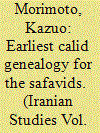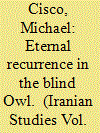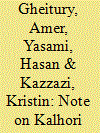|
|
|
Sort Order |
|
|
|
Items / Page
|
|
|
|
|
|
|
| Srl | Item |
| 1 |
ID:
098432


|
|
|
|
|
| Publication |
2010.
|
| Summary/Abstract |
Studies on the pre-dynastic claim of the Safavids to sayyid status suffer from a dearth of primary source materials. Scholars have advanced various conjectures, but it is not yet clear when the Safavids began to promote this claim or indeed when the so-called "official" Musavid genealogy was developed. This study presents a genealogical chart drawn in the third quarter of the fifteenth century (most probably in the 1460s) in Iraq (most likely in Najaf), which records the "official" genealogy in an unequivocal manner. This chart is a valuable document in that it testifies to the circulation of the "official" genealogy some three to four decades before the establishment of the Safavid dynasty. A survey of the studies to date on the question of the pre-dynastic claim is also offered in order to clarify the significance of the chart.
|
|
|
|
|
|
|
|
|
|
|
|
|
|
|
|
| 2 |
ID:
098433


|
|
|
|
|
| Publication |
2010.
|
| Summary/Abstract |
This article analyzes the surprisingly consistent way in which Sadeq Hedayat's novella, The Blind Owl, represents the concept of eternal recurrence. Hedayat employs repetition in a unique manner. Neither narrator ever remarks upon or seems to notice that events, motifs, and similar or identical epithets and phrasings which arise in their own thoughts and utterances are repeating, but they rather encounter every repeated event or thought as if it had only just occurred for the first time. While I do not claim that Hedayat was in any meaningful way a 'Nietzschean' thinker, philosophical ideas from Nietzsche's works and those of the French thinkers who came after, most notably Klossowski and Deleuze, interact strikingly with The Blind Owl and seem to bring hitherto unnoticed dimensions of this important work to our attention. Notably, Hedayat depicts a struggle with nihilism that is informed by the philosophical questions surrounding what came to be known as existentialism, but in a manner that is not merely derivative of European models.
|
|
|
|
|
|
|
|
|
|
|
|
|
|
|
|
| 3 |
ID:
098436


|
|
|
|
|
| Publication |
2010.
|
| Summary/Abstract |
Despite the great number of studies conducted by Western scholars exploring kinship terminologies in different languages, there seems to have been little attempt at dealing with kin words in Iranian languages like Kurdish. More specifically, Kalhori, as a southern dialect of Kurdish, has rarely been subject to studies of this nature. Underlining the significance of such studies in the wider linguistic and anthropological contexts, this study attempts to explore kin words Kalhori speakers use to refer to or address their relatives. We also make an attempt to investigate the possibility of presenting a formal explanation of the terms by placing them in a componential analysis framework.
|
|
|
|
|
|
|
|
|
|
|
|
|
|
|
|
| 4 |
ID:
098435


|
|
|
|
|
| Publication |
2010.
|
| Summary/Abstract |
This study aims to analyze the positions and syntactic functions of dependent and independent personal pronouns in the Kakavandi Laki dialect in the region of Harsin (Kermanshah/Iran), an endangered dialect of Persian. The paper provides a morpho-syntactic description and investigates the dialectal characteristic positions of the pronominals in regard to their syntactic functions, which illustrate noticeable differences in comparison to Persian. The main functions under investigation include: subjective, objective, oblique and possessives, on the basis of which the pronominal positional variety is classified in the dialect. The study further examines the dialectal agreement patterns which demonstrate both ergative and non-ergative features.
|
|
|
|
|
|
|
|
|
|
|
|
|
|
|
|
| 5 |
ID:
098434


|
|
|
|
|
| Publication |
2010.
|
| Summary/Abstract |
This essay explores two primary concerns in the art and artistic practice of contemporary Iran, namely "identity" (i.e. local, historical, imagined and collective identity and also self-identity) and "exoticism" (which appears inevitably related to the first), both of which (identity and exoticism) involve challenges relating to the "self" and "other" and the issue of "expectation". It suggests that these issues see broader contextual socio-political parallels. The first apprehension relates to the concept of identity which addresses how artists have interpreted contemporary aesthetics in the light of national and indigenous ideology. The second refers to the ever-present obsession with cultural and frequently social concern with which Iranian artists are engaged within the country. The two concerns are integrated, in the way that the second is seen to be the outcome of the first. Some critiques are based on the issues of cultural commodification, anti-canonical West, cultural formulation, and also the stereotypes rooted in the preference and interest of the market.
|
|
|
|
|
|
|
|
|
|
|
|
|
|
|
|
|
|
|
|
|